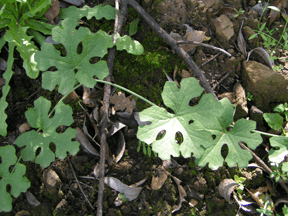Taw manroot facts for kids
Quick facts for kids Taw manroot |
|
|---|---|
 |
|
| Scientific classification | |
| Genus: |
Marah
|
| Species: |
watsonii
|
The Marah watsonii, also known as the taw manroot, is a special plant found only in central northern California. It's quite rare! This plant grows in the eastern coastal hills, the western parts of the northern Sierra Nevada mountains, and the Cascades ranges. You can find it from Lake Berryessa in the south all the way up to Shasta Lake in the north.
Contents
What Does Taw Manroot Look Like?
Stems and Leaves
Like all plants in the Marah family, the taw manroot has stems that don't twist around things. Instead, they have special parts called tendrils that help them climb or spread out. What makes the taw manroot special is that its vines are almost smooth and have a cool, grey-green color, like they're covered in a light powder.
These vines start to grow in late winter or early spring when it rains more. They can climb or spread up to 6 meters (about 20 feet) long! The leaves of the taw manroot are very unique. They are deeply cut and have many lobes, which means they look a bit like pieces of a jigsaw puzzle.
The Big Root (Tuber)
The vines grow from a very large, hard root that is shaped like a tuber. This root can be several meters long and weigh more than 100 kilograms (over 220 pounds)! If you see newly uncovered tubers along roads or on hills where the soil has washed away, they look scaly and tan. If a tuber gets hurt or starts to decay, it turns a golden or orange color.
Flowers and How They Grow
The taw manroot has white flowers that appear soon after the vine starts to grow. These plants have a cool way of making new plants. They are monoecious, which means that each plant has both male and female flowers. The male flowers grow in open groups, like spikes. The female flowers are easy to spot because they have a swollen base and usually hang down by themselves from the male flower-spike.
The plant can fertilize itself, meaning pollen from its own male flowers can fertilize its female flowers. Tiny insects help move the pollen around.
Fruit and Seeds
The fruit of the taw manroot is round or slightly oval, about 6 to 8 centimeters (2.4 to 3.1 inches) across. It hangs from a long, wrinkled stem. Unlike other manroot fruits, the taw manroot's fruit has fewer, stronger, horn-like spikes that become smooth ridges at the bottom. Some plants even have smooth fruit with dark green lines running from top to bottom.
When the fruit is young, it's light green, sometimes with faint dark green stripes. As it ripens, it turns yellow. The fruit starts to grow in spring and ripens as the vine begins to die from the summer heat and dry weather. The fruit swells up as it ripens until it finally bursts open, shooting out its large seeds. In places with more moisture, the vine might stay green even after the fruit has burst.
Seeds and Their Special Start to Life
The seeds of the Marah watsonii are rounder than those of other manroot plants. Each fruit usually holds four or more of these big seeds. These seeds have a very unusual way of starting to grow, which is called germination.
First, a shoot comes out of the seed and grows downward into the ground. Then, this shoot splits into two parts. One part starts to swell up and forms the large tuber (the big root). The second part grows back up to the surface and becomes the vine you see above ground!
Where Does Taw Manroot Live?
Taw manroot grows best near streams or in dry riverbeds called washes. However, it can also do well in drier areas, growing at elevations up to 1,600 meters (about 5,250 feet). It can grow in many different types of soil and doesn't mind if the soil is acidic or not. But it does need the soil to be at least a little bit wet for part of the year. The vines can grow in full sunshine or in very shady spots. The vines die back in the summer heat and then grow again in late winter.
How People Have Used Taw Manroot
All parts of the taw manroot plant taste very bitter. In fact, the name Marah comes from the Hebrew word for "bitter." Even though it's bitter, the leaves have sometimes been used as a vegetable. The large tuber of the manroot can also be processed to make a soap-like liquid.
Images for kids


